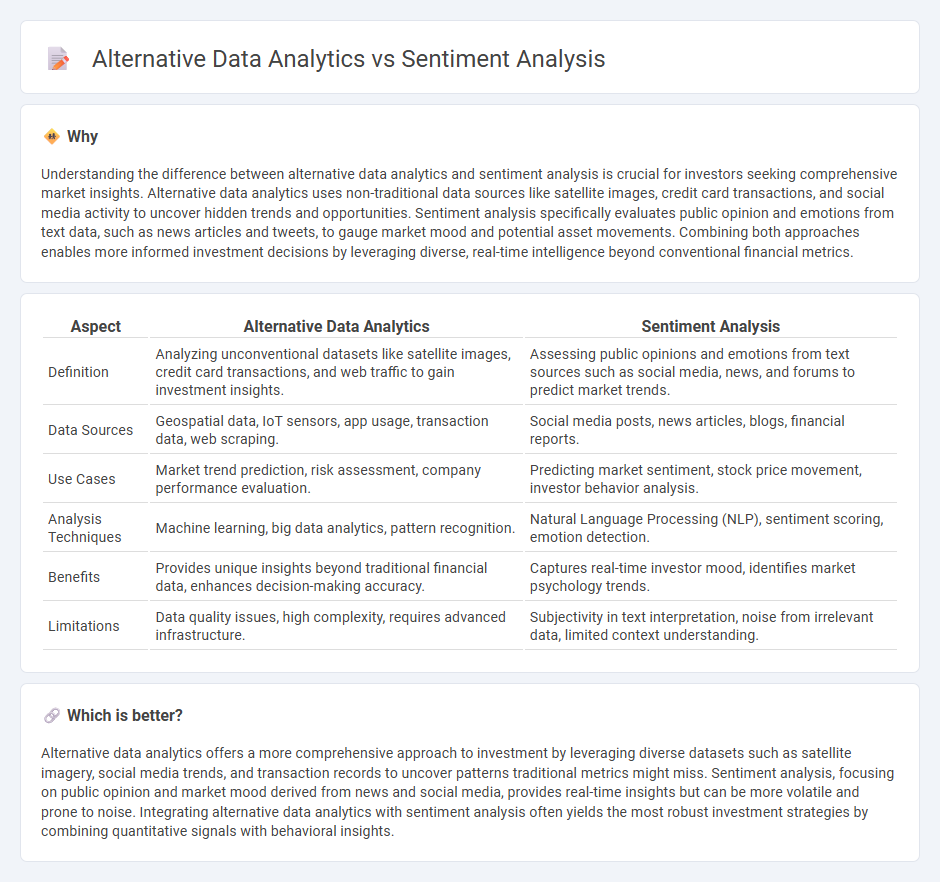
Alternative data analytics harnesses non-traditional data sources like satellite images, social media trends, and transaction records to uncover investment opportunities beyond standard financial metrics. Sentiment analysis focuses on interpreting public mood and investor emotions through text data from news, social media, and forums to predict market movements. Explore how these innovative approaches reshape investment strategies and decision-making.
Why it is important
Understanding the difference between alternative data analytics and sentiment analysis is crucial for investors seeking comprehensive market insights. Alternative data analytics uses non-traditional data sources like satellite images, credit card transactions, and social media activity to uncover hidden trends and opportunities. Sentiment analysis specifically evaluates public opinion and emotions from text data, such as news articles and tweets, to gauge market mood and potential asset movements. Combining both approaches enables more informed investment decisions by leveraging diverse, real-time intelligence beyond conventional financial metrics.
Comparison Table
| Aspect | Alternative Data Analytics | Sentiment Analysis |
|---|---|---|
| Definition | Analyzing unconventional datasets like satellite images, credit card transactions, and web traffic to gain investment insights. | Assessing public opinions and emotions from text sources such as social media, news, and forums to predict market trends. |
| Data Sources | Geospatial data, IoT sensors, app usage, transaction data, web scraping. | Social media posts, news articles, blogs, financial reports. |
| Use Cases | Market trend prediction, risk assessment, company performance evaluation. | Predicting market sentiment, stock price movement, investor behavior analysis. |
| Analysis Techniques | Machine learning, big data analytics, pattern recognition. | Natural Language Processing (NLP), sentiment scoring, emotion detection. |
| Benefits | Provides unique insights beyond traditional financial data, enhances decision-making accuracy. | Captures real-time investor mood, identifies market psychology trends. |
| Limitations | Data quality issues, high complexity, requires advanced infrastructure. | Subjectivity in text interpretation, noise from irrelevant data, limited context understanding. |
Which is better?
Alternative data analytics offers a more comprehensive approach to investment by leveraging diverse datasets such as satellite imagery, social media trends, and transaction records to uncover patterns traditional metrics might miss. Sentiment analysis, focusing on public opinion and market mood derived from news and social media, provides real-time insights but can be more volatile and prone to noise. Integrating alternative data analytics with sentiment analysis often yields the most robust investment strategies by combining quantitative signals with behavioral insights.
Connection
Alternative data analytics leverages unconventional data sources such as social media, satellite imagery, and transaction records to uncover investment opportunities and market trends. Sentiment analysis processes textual data from news, forums, and social platforms to gauge investor mood and predict market movements. Integrating sentiment analysis within alternative data analytics enhances the precision of investment decisions by providing real-time insights into market sentiment and behavioral patterns.
Key Terms
**Sentiment Analysis:**
Sentiment analysis leverages natural language processing (NLP) and machine learning algorithms to assess emotions and opinions expressed in text data from social media, reviews, and news articles. This technique enables businesses to gauge consumer sentiment, monitor brand reputation, and predict market trends by interpreting subjective information at scale. Explore the latest advancements in sentiment analysis to enhance your data-driven decision-making strategies.
Natural Language Processing (NLP)
Sentiment analysis utilizes Natural Language Processing (NLP) to interpret and classify emotions expressed in text, enabling businesses to gauge customer opinions and market trends effectively. Alternative data analytics leverages NLP to extract insights from unconventional sources such as social media feeds, online reviews, and news articles, providing a broader context for decision-making. Discover how integrating sentiment analysis with alternative data enhances predictive accuracy and strategic planning.
Market Sentiment Indicators
Sentiment analysis leverages natural language processing to quantify market sentiment by analyzing news, social media, and financial reports, providing real-time insights into investor mood. Alternative data analytics extends beyond traditional datasets to include unconventional sources such as satellite imagery, web traffic, and credit card transactions, enhancing market sentiment indicators with diverse and predictive signals. Explore how combining sentiment analysis with alternative data can revolutionize market sentiment indicators and investment strategies.
Source and External Links
Sentiment Analysis and How to Leverage It - Qualtrics - Sentiment analysis is the process of identifying and interpreting qualitative data to understand feelings about a topic, with common types including fine-grained, aspect-based, and intent-based sentiment analysis that measure intensity, evaluate specific components, or uncover the reason behind a statement respectively.
What Is Sentiment Analysis? - IBM - Sentiment analysis, or opinion mining, analyzes text to classify it as positive, negative, or neutral and helps companies gain insights from vast textual data sources such as reviews, social media, and customer interactions to improve customer experience and brand reputation.
What is Sentiment Analysis? - AWS - Sentiment analysis determines the emotional tone of digital text (positive, negative, neutral) and includes various methods like fine-grained scoring, aspect-based, intent-based, and emotional detection to support businesses in understanding customer sentiment deeply and contextually.
 dowidth.com
dowidth.com